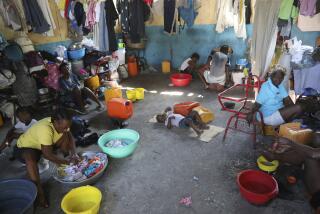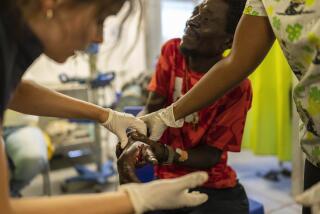Haiti’s Economy Mired in Woes
- Share via
PORT-AU-PRINCE, Haiti — Preparing for Secretary of State Madeleine Albright’s recent visit to Haiti, U.S. Embassy aides selected as one of her prospective stops a giant flour mill, a site that struck them as the perfect symbol of what this Caribbean country must do in its arduous march toward economic well-being.
The mill, now controlled by a consortium of American and other private investors, is the first public enterprise sold by the Haitian government under its new privatization program. A visit by Albright would have emphasized the importance of privatization and foreign investment.
But when members of the advance staff reached the mill, they were in for a surprise: Occupying it were angry former workers demanding more severance pay. The embassy hurriedly canceled Albright’s planned stop.
The incident reflects the problems involved in trying to bolster the economy of Haiti, which has been the poorest and sickliest nation in the Western Hemisphere.
So far, the end of military rule and the return of democracy under the protection of 20,000 U.S. troops three years ago have done little to turn its moribund economy around.
And even the first, small steps toward economic reform have been stymied by the country’s political situation.
The government is paralyzed by an impasse between President Rene Preval and the opposition-controlled congress.
The economy of Port-au-Prince, in fact, has hardly changed in four decades that have witnessed the tyrannies of Francois “Papa Doc” Duvalier and his son, Jean-Claude “Baby Doc” Duvalier; the chaotic, dictatorial rule of military juntas; the election, ouster and return of President Jean-Bertrand Aristide; the military occupation by U.S. and U.N. troops; and the current reign of Aristide’s handpicked successor, Preval.
The streets of the capital, more populous than ever, are still strewn with rubble, clogged with fuming and rusted autos and crowded with beggars and hawkers. Hundreds of women try to earn a few gourdes by selling meager supplies of pencils, old clothes, soap or other cheap goods. Scores of children elbow their way to public faucets and carry water home in pails perched on their heads. Rivulets of waste seep down shallow open sewers. Electricity comes on and goes out through the day.
In a recent survey, the World Bank reports that Haiti’s per capita gross domestic product--$250 a year--school enrollment and literacy rate are the lowest in the hemisphere. Unemployment is estimated at 70%. Tuberculosis and malnutrition are widespread, and the country is subject to epidemics of measles, meningitis, rabies and anthrax.
The population, now about 7 million, is projected to reach 20 million by 2040. The agricultural production by peasants, who make up two-thirds of the population, has been dwindling, forcing them to join the ranks of the unemployed in Port-au-Prince or cut down what is left of the forests on the country’s largely eroded mountains.
*
The government bureaucracy, the World Bank says, “is undertrained, and its institutional procedures are ill-suited to support a modern, market-oriented economy and society.”
For all of the staggering problems facing the country, many outsiders insist that the Haitian situation is not hopeless.
“I haven’t lost all hope,” said Sen. Christopher J. Dodd (D-Conn.), who accompanied Albright on her trip. “It just takes the ordering of a few things to get started.”
Still, the economy’s continuing failure has angered the Haitian people, who are turning away from the political system. Less than 10% of the electorate voted in April’s senatorial elections.
More to Read
Sign up for Essential California
The most important California stories and recommendations in your inbox every morning.
You may occasionally receive promotional content from the Los Angeles Times.










